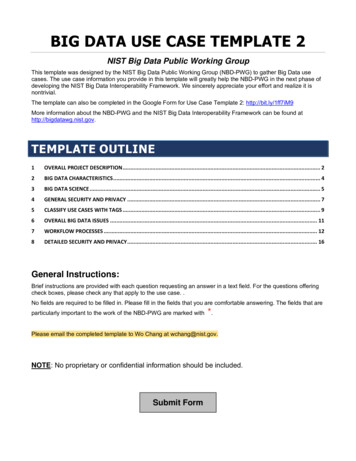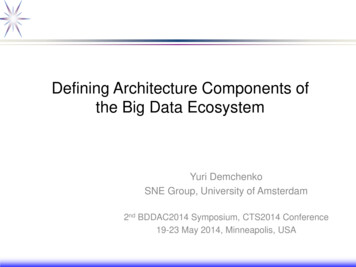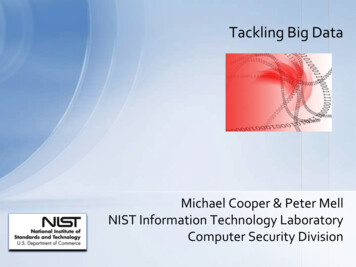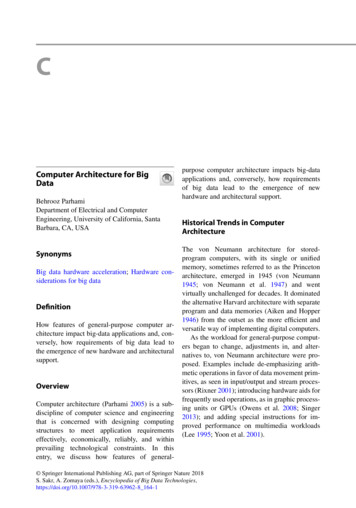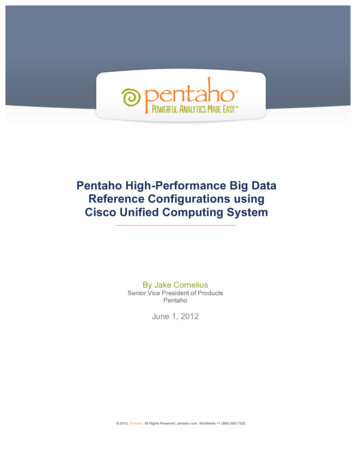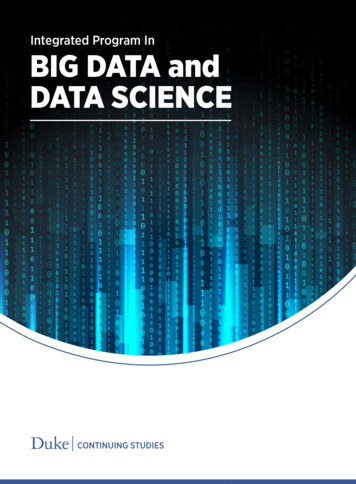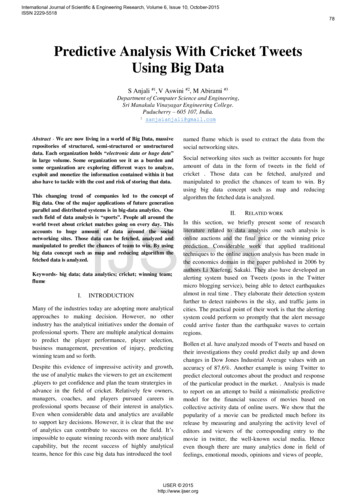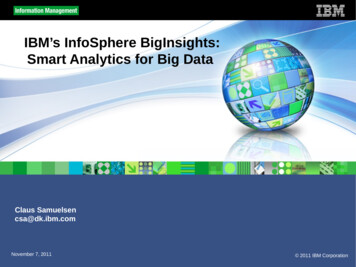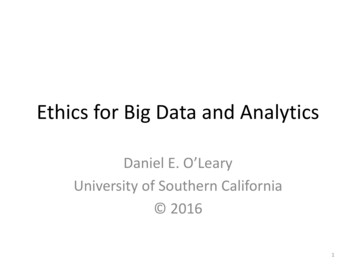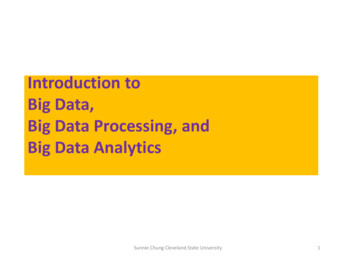
Transcription
Introduction toBig Data,Big Data Processing, andBig Data AnalyticsSunnie Chung Cleveland State University1
What’s Big Data?From Wikipedia: Big data is the term for a collection of data sets so large and complexthat it becomes difficult to process using on-hand databasemanagement tools or traditional data processing applications. The challenges include capture, curation, storage, search, sharing,transfer, analysis, and visualization. The trend to larger data sets is due to the additional informationderivable from analysis of a single large set of related data, as comparedto separate smaller sets with the same total amount of data, allowingcorrelations to be found to "spot business trends, determine quality ofresearch, prevent diseases, link legal citations, combat crime, anddetermine real-time roadway traffic conditions.”Sunnie Chung Cleveland State University2
Big Data: 3V’sSunnie Chung Cleveland State University3
Volume (Scale) Data Volume– 44x increase from 2009 2020– From 0.8 zettabytes to 35zb Data volume is increasing exponentiallyExponential increase incollected/generated dataSunnie Chung Cleveland State University4
30 billion RFIDtags today(1.3B in 2005)12 TBscameraphonesworld wide100s ofmillionsof GPSenableddata every day? TBs ofof tweet dataevery day4.6billiondevices soldannually25 TBs of2 billionlog dataevery day76 million smart metersin 2009 200M by 2014Sunnie Chung Cleveland State Universitypeople onthe Webby end20115
Maximilien Brice, CERNSunnieColliderChung ClevelandStateUniversity 15 PB a yearCERN’s Large Hydron(LHC)generates6
The EarthScope The Earthscope is the world'slargest science project. Designed totrack North America's geologicalevolution, this observatory recordsdata over 3.8 million square miles,amassing 67 terabytes of data. Itanalyzes seismic slips in the SanAndreas fault, sure, but also theplume of magma underneathYellowstone and much, much more. http://www.msnbc.msn.com/id/44363598/ns/technology and sciencefuture of technology/#.TmetOdQ--uISunnie Chung Cleveland State University7
Variety (Complexity) Relational Data (Tables/Transaction/Legacy Data)Text Data (Web)Semi-structured Data (XML)Graph Data– Social Network, Semantic Web (RDF), Streaming Data– You can only scan the data once A single application can be generating/collectingmany types of data Big Public Data (online, weather, finance, etc)To extract knowledge all these types ofdata need to linked togetherSunnie Chung Cleveland State University8
A Single View to the stomerGamingPurchaseEntertainSunnie Chung Cleveland State University9
Velocity (Speed) Data is begin generated fast and need to beprocessed fast Online Data Analytics Late decisions missing opportunities Examples– E-Promotions: Based on your current location, your purchase history,what you like send promotions right now for store next to you– Healthcare monitoring: sensors monitoring your activities and body any abnormal measurements require immediate reactionSunnie Chung Cleveland State University10
Real-time/Fast DataMobile devices(tracking all objects all the time)Social media and networks(all of us are generating data)Scientific instruments(collecting all sorts of data)Sensor technology and networks(measuring all kinds of data) The progress and innovation is no longer hindered by the ability to collect dataBut, by the ability to manage, analyze, summarize, visualize, and discoverknowledge from the collected data in a timely manner and in a scalable fashionSunnie Chung Cleveland State University11
Real-Time Analytics/Decision RequirementProductRecommendationsthat are Relevant& CompellingImproving theMarketingEffectiveness of aPromotion while itis still in PlayInfluenceBehaviorLearning why CustomersSwitch to competitorsand their offers; intime to CounterCustomerFriend Invitationsto join aGame or Activitythat expandsbusinessPreventing Fraudas it is Occurring& preventing moreproactivelySunnie Chung Cleveland State University12
Some Make it 4V’sSunnie Chung Cleveland State University13
Harnessing Big Data OLTP: Online Transaction Processing (DBMSs)OLAP: Online Analytical Processing (Data Warehousing)RTAP: Real-Time Analytics Processing (Big Data Architecture & Technology)Sunnie Chung Cleveland State University14
The Model Has Changed The Model of Generating/Consuming Data has ChangedOld Model: Few companies are generating data, all others are consuming dataNew Model: all of us are generating data, and all of us are consuming dataSunnie Chung Cleveland State University15
What’s driving Big Data- Optimizations and predictive analytics- Complex statistical analysis- All types of data, and many sources- Very large datasets- More of a real-time- Ad-hoc querying and reporting- Data mining techniques- Structured data, typical sources- Small to mid-size datasetsSunnie Chung Cleveland State University16
THE EVOLUTION OF BUSINESS INTELLIGENCESpeedBI ReportingOLAP &Dataware houseBusiness Objects, SAS,Informatica, Cognos other SQLReporting ToolsInteractive BusinessIntelligence &In-memory RDBMSQliqView, Tableau, HANAScaleBig Data:Real Time &Single ViewGraph DatabasesBig Data:Batch Processing &Distributed Data StoreScaleSpeedHadoop/Spark; HBase/Cassandra1990’s2000’sSunnie Chung Cleveland State University2010’s17
Big Data Analytics Big data is more real-time in naturethan traditional DW applications Traditional DW architectures (e.g.Exadata, Teradata) are not wellsuited for big data apps Shared nothing, massively parallelprocessing, scale out architecturesare well-suited for big data appsSunnie Chung Cleveland State University18
Sunnie Chung Cleveland State University19
Big Data TechnologySunnie Chung Cleveland State University20
Cloud Computing IT resources provided as a service– Compute, storage, databases, queues Clouds leverage economies of scale ofcommodity hardware– Cheap storage, high bandwidth networks &multicore processors– Geographically distributed data centers Offerings from Microsoft, Amazon, Google, Sunnie Chung Cleveland State University21
Sunnie Chung ClevelandState Universitywikipedia:CloudComputing22
Benefits Cost & management– Economies of scale, “out-sourced” resourcemanagement Reduced Time to deployment– Ease of assembly, works “out of the box” Scaling– On demand provisioning, co-locate data and compute Reliability– Massive, redundant, shared resources Sustainability– Hardware not ownedSunnie Chung Cleveland State University23
Types of Cloud Computing Public Cloud: Computing infrastructure is hosted at thevendor’s premises. Private Cloud: Computing architecture is dedicated to thecustomer and is not shared with other organisations. Hybrid Cloud: Organisations host some critical, secureapplications in private clouds. The not so critical applicationsare hosted in the public cloud– Cloud bursting: the organisation uses its own infrastructure for normalusage, but cloud is used for peak loads. Community CloudSunnie Chung Cleveland State University24
Classification of Cloud Computingbased on Service Provided Infrastructure as a service (IaaS)– Offering hardware related services using the principles of cloudcomputing. These could include storage services (database or diskstorage) or virtual servers.– Amazon EC2, Amazon S3, Rackspace Cloud Servers and Flexiscale. Platform as a Service (PaaS) – Offering a development platform on the cloud.– Google’s Application Engine, Microsofts Azure, Salesforce.com’sforce.com .Software as a service (SaaS)– Including a complete software offering on the cloud. Users canaccess a software application hosted by the cloud vendor on payper-use basis. This is a well-established sector.– Salesforce.coms’ offering in the online Customer RelationshipManagement (CRM) space, Googles gmail and Microsofts hotmail,Google docs.Sunnie Chung Cleveland State University25
Infrastructure as a Service (IaaS)Sunnie Chung Cleveland State University26
More Refined Categorization a-service Testing-as-a-service Infrastructure-as-a-serviceInfoWorld Cloud Computing Deep DiveSunnie Chung Cleveland State University27
Key Ingredients in Cloud Computing Service-Oriented Architecture (SOA)Utility Computing (on demand)Virtualization (P2P Network)SAAS (Software As A Service)PAAS (Platform AS A Service)IAAS (Infrastructure AS A Servie)Web Services in CloudSunnie Chung Cleveland State University28
Enabling Technology: VirtualizationAppAppAppAppAppAppOSOSOSOperating SystemHypervisorHardwareHardwareTraditional StackVirtualized StackSunnie Chung Cleveland State University29
Everything as a Service Utility computing Infrastructure as a Service(IaaS)– Why buy machines when you can rent cycles?– Examples: Amazon’s EC2, Rackspace Platform as a Service (PaaS)– Give me nice API and take care of the maintenance,upgrades, – Example: Google App Engine Software as a Service (SaaS)– Just run it for me!– Example: Gmail, SalesforceSunnie Chung Cleveland State University30
Cloud versus cloud Amazon Elastic Compute CloudGoogle App EngineMicrosoft AzureGoGridAppNexusSunnie Chung Cleveland State University31
The Obligatory Timeline Slide(Mike Culver @ bAwarenessWeb as aPlatformDot-Com BubbleSunnie Chung Cleveland State UniversityWeb Services,Resources EliminatedWeb 2.0Web ScaleComputing32
AWS Elastic Compute Cloud – EC2 (IaaS)Simple Storage Service – S3 (IaaS)Elastic Block Storage – EBS (IaaS)SimpleDB (SDB) (PaaS)Simple Queue Service – SQS (PaaS)CloudFront (S3 based Content DeliveryNetwork – PaaS) Consistent AWS Web Services APISunnie Chung Cleveland State University33
What does Azure platform offer todevelopers?Sunnie Chung Cleveland State University34
Google’s AppEngine vs Amazon’s EC2PythonBigTableOther API’sVMsFlat File StorageAppEngine: Higher-level functionality(e.g., automatic scaling) More restrictive(e.g., respond to URL only) Proprietary lock-inEC2/S3: Lower-level functionality More flexible Coarser billing modelSlide 35Sunnie Chung Cleveland StateUniversity
Big data is the term for a colle ion of data sets so large and complex that it becomes diffi lt to pro ss using on-hand da tabase management tools or traditional data pro ssing appl ications. . (Big Data Architecture &
